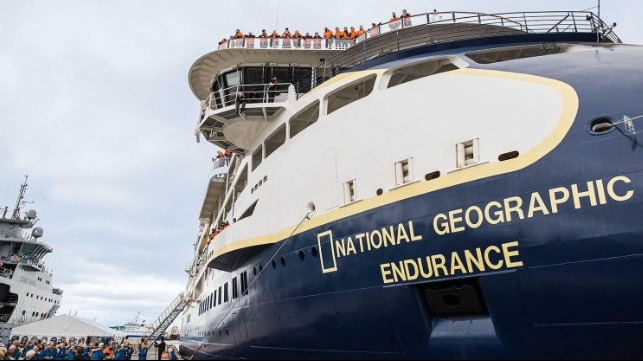Lindblad's X-Bow Expedition Cruise Ship Sets Sail on Maiden Voyage

Lindblad Expedition's new purpose-built polar cruise ship, the National Geographic Endurance, has embarked on her maiden commercial voyage after a christening ceremony in Reykjavik. The event was the first of its kind for an international vessel in the city's harbor. The christening was presided over by not one but two sponsors, Lindblad director of field staff Jen Martin and director of hotel operations Ana Esteves.
National Geographic Endurance is a 126-passenger expedition cruise ship built to IACS Polar Class 5 Category A specifications (year-round operation in medium first-year ice). This is roughly equivalent to the specifications of the South African icebreaker Agulhas II, and it makes Endurance the toughest passenger vessel in operation today. She has an X-Bow hull, a feature that is desirable for low slamming on sustained speed transits in heavy weather. Given her small scale and hardy design, it was possible for two non-cruise shipyards - CRIST in Poland, which built the hull, and Ulstein, which did the interiors and final outfitting - to complete her construction.
Her maiden voyage will be a 19-day tour of Iceland and Greenland, with the possibility of landing passengers on Greenland's shores. Fares start at $22,000 per person, or a bit more than $1,100 per person per day - roughly seven times the cruise-industry average for full-size ships.
The Endurance may not hold the title of highest-ice-class passenger vessel for long. Ponant's Le Commandant Charcot, a genuine icebreaker built to the PC2 standard, recently completed its ice trials in the Arctic and has returned to port near Andalsnes, Norway. She is the only vessel of any kind built to Polar Class PC2, denoting year-round operation in moderate multi-year ice. The majority of recently built government research icebreakers are designed to less demanding standards (PC3 or PC4).
[Live] #LeCommandantCharcot, #PONANT’s newest ship, has entered the third phase of trials in #Greenland, to carry out a battery of tests under real conditions.
— PONANT Cruises (@ponant_cruises) June 25, 2021
???? © PONANT pic.twitter.com/6DgidTkEeJ
